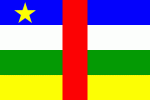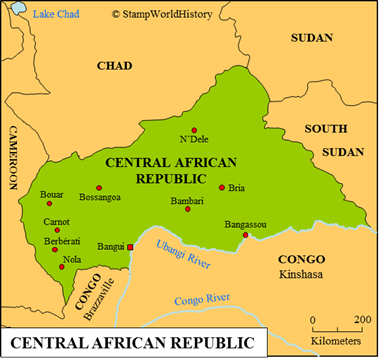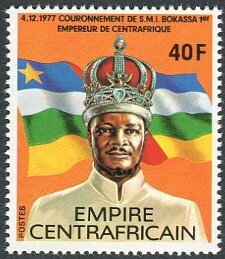
Central African Republic
Quick reference
General issues: French colony, self government 1959-1960, Republic 1960-1976, Empire 1976-1979, Republic 1979-Present
Country name on general issues: Republique Centrafricaine, Empire Centrafricain
Currency: 1 (CFA) Franc = 100 Centimes
Population: 1 193 000 in 1959, 4 709 000 in 2014
Political history Central African Republic
The Central African Republic is located in central Africa. The largest part of the population consists of Niger-Congo peoples of which the Baya and Banda are the largest groups. To the north live Nilo-Saharan peoples of which the Sara – also living in neighboring Chad – are the largest group. Europeans explore the region from 1885. The French in 1889 settle in Bangui – the future capital of the Central African Republic. In 1894, the French proclaim what is then called Ubangi-Shari, a French territory. Ubangi-Shari, in 1910, becomes part of French Equatorial Africa and, in 1914, is raised to the status of a colony. The borders with the non-French neighboring countries are defined through treaties in the 1890’s. The borders with the neighboring French possessions – Middle Congo, now Congo Brazzaville, and Chad – will change frequently until, in 1936, the borders are established as we know them today.
In 1946, Ubangi-Shari becomes – as do all French possessions – a French overseas territory. From the 1940’s, Ubangi-Shari moves towards independence. In 1958, self government is gained as the Central African Republic. The Central African Republic gains full independence in 1960.
The political history of the Central African Republic is one of political instability. In 1965, Bokassa comes to power through a coup d’etat. Bokassa suspends the constitution and dissolves parliament. In 1976, Bokassa proclaims himself emperor of the Central African Empire. Bokassa is brought down in 1979, after a French military intervention upon which the republic is restored. The intervention will, however, will not bring political stability for long. In 1981, yet another coup d’etat will bring a military junta to power. Under international pressure, in the 1990’s, democratic reforms are implemented. Conflicts are not resolved though and, from 2003, the country has been in a de facto state of civil war.
The backbone of the Central African Republic’s economy is subsistence agriculture. Cotton – introduced in the colonial era – is the most important cash crop. Timber, minerals and cotton account for the largest part of the export. The Central African Republic, in terms of per capita GDP, ranks 230 out of 230 countries in the world.
Postal history Central African Republic
The first post office to be opened in what will become the Central African Republic is the office in Bangui – opened in 1893. Stamps used are successively those of French Congo, Middle Congo, Ubangi-Shari-Chad, Ubangi-Shari and French Equatorial Africa. Having gained self government, the Central African Republic will issue stamps from 1959 – the first issue commemorating the first anniversary of the establishment of the republic. The independent Central African Republic will issue stamps from 1960. From 1977 to 1979, the stamps are inscribed ‘Empire Centrafricain’.
The stamps issued by the Central African Republic are, in the 1960’s and 1970’s, a mix of themes of national interest and themes aimed at the thematic collectors market – many of the designs being in the French design tradition. From the 1980’s, the stamps issued are almost exclusively aimed at the thematic collectors market.
Album pages
← Previous page: Cape VerdeNext page: Chad →




